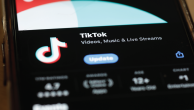Cell Phones, DVDs, DVRs on the Rise
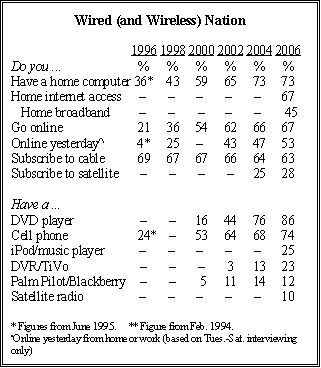
Americans own a wide and growing array of electronic devices and services for communication and entertainment. The vast majority of households (86%) have a digital video disc (DVD) player, and nearly as many (82%) subscribe to cable or satellite television services. The digital video recorder (DVR or TiVo), owned by just 3% of respondents four years ago, is now found in nearly one-quarter (23%) of households. A similar number of respondents (25%) report having an iPod or other digital music player, and 10% report having a subscription to a satellite radio service such as XM or Sirius.
The number of Americans who have a home computer has remained stable over the past two years (73% in both years), but the number who go online has edged upward, with 67% now reporting that they do this and 53% reporting having done so yesterday from either home or work. Moreover, the number who go online from home with a high-speed internet connection has been rapidly rising and now constitutes nearly half of the public (45%). But there has been no growth in the number who say they have a Palm Pilot, Blackberry, or other similar product (12% this year, 14% in 2004).
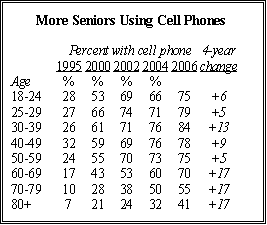
Cell phones are also becoming more common, with nearly three-quarters of Americans (74%) reporting that they have one. Men and women are equally likely to report having a cell phone, and the percentage of senior citizens with cell phones continues to climb very rapidly. Among Americans 60 and older, 59% now have a cell phone.
Portable Electronic Devices: New Gateway for News?
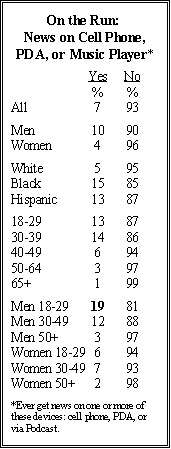
Many of the portable electronic devices that Americans use are capable of playing prerecorded news and commentary or receiving news headlines or stories. Among cell phone users, 6% say they receive news headlines or read news reports on their cell phones, and about half of those do so at least a few times a week. Nearly one-in-five people with a PDA (18%) receive news on these devices. And among those with an iPod or other portable music player, 8% say they listen to news podcasts, including 5% who do so at least a few times a week.
A relatively small number of Americans about 7% of the general public are getting news via one or more of these types of electronic devices, with just 4% doing so at least a few times a week. But among some groups in the population, the numbers are substantially higher. For example, among young men (ages 18-29) nearly one-in-five (19%) report getting news this way, as do 15% of African Americans and 13% of Hispanics.
One other technology that may help the on-the-go American stay informed is the DVR. Nearly one-in-five DVR owners (17% or approximately 4% of all households) say they have their DVR programmed to regularly record a news program.
Public’s Knowledge
A solid majority of Americans know a key fact about the current political environment: 64% can correctly identify the Republicans as the party that has a majority in the U.S. House of Representatives. That is up from 56% in April 2004, but is not as high as in the months after the GOP regained the majority in November 1994.
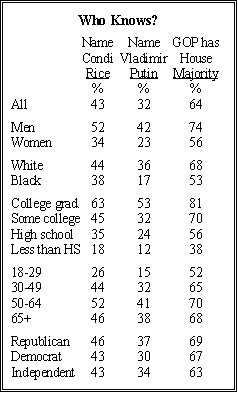
But fewer people are able to recall the names of two important political figures on the international scene. Just over four-in-ten (43%) can name Condoleezza Rice as the current secretary of state, the same number who could name her when she was appointed to the position following the 2004 election. Slightly more could name her predecessor, Colin Powell, in April 2002 (48%).
Even fewer could name Vladimir Putin as the current president of Russia; 32% accurately recalled his name, down from 37% in late October 2005. His predecessor, Boris Yeltsin, was somewhat better known to the American public, with 44%-50% of individuals surveyed able to name Yeltsin as the president of Russia in polls conducted between 1994 and 1997.
Overall, about one-fourth of the public (24%) knew all three facts, while 28% knew none of them.
There are large differences in knowledge of these three facts across groups in the population. Education is a strong predictor of knowledge for each. There are sizable gender differences as well. Women are 18 percentage points less likely than men to be able to name Rice, who is the second female secretary of state in the nation’s history. There is also a fairly large knowledge gap between whites and blacks on naming Putin, and knowing that the Republicans control the House of Representatives, but a much smaller racial difference in naming Rice (six percentage points). On all three knowledge items, differences between Republicans and Democrats are fairly small.
Cell-Only Households’ News Usage
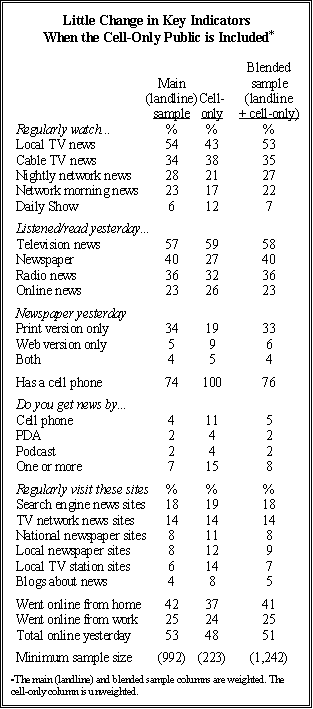
Survey researchers are increasingly concerned about the growing number of people who cannot be reached on a landline telephone and have only a cell phone, a group estimated by government studies to be 7%-9% of the public. Compared with people who have a landline, these individuals tend to be younger, less affluent, and less educated. These characteristics are also associated with lower levels of news consumption, raising the question of whether studies that rely on conventional random digit dialing samples may be overestimating the true levels of media use.
To evaluate the news usage of the cell-only population, Pew conducted a shorter version of the media consumption survey with a sample of 250 people who have a cell phone but no landline telephone. Respondents were interviewed on their cell phones, using a sample drawn from a nationally representative cell telephone number database. The interviews were conducted May 15 – June 3, 2006.
News consumption for some sources especially newspapers was lower among cell-only respondents than among those with a landline phone. However, when the cell-only respondents are included with the respondents reached on a landline, and this blended sample is weighted to match the full U.S. population demographically and with respect to telephone status, overall estimates of news consumption are affected by an average of less than one percentage point.
Much of the difference between the landline and cell-only samples is a result of the fact that the cell-only group is much younger, on average, than the landline sample. 56% of the cell-only respondents were under 30 years of age, compared with just 14% in the unweighted landline sample. Younger people tend to be much less likely to read newspapers or watch network newscasts. The normal demographic weighting applied to the landline sample helps to compensate for the under-representation of young people, and mitigates the absence of the cell-only population.

This result occurs in large part because younger people accessible by landline are not especially different in media consumption habits from those who are reachable only on a cell phone. On nearly every measure of news consumption, there was no statistically significant difference between 18-29 year olds interviewed on a landline and those interviewed on a cell phone.
These findings are consistent with a Pew report, released in May, which focused on political attitudes. Examining a range of questions, it found that the cell-only trend has not yet seriously undermined public opinion polls that use the random digit dialing method (see “The Cell Phone Challenge to Survey Research“)


